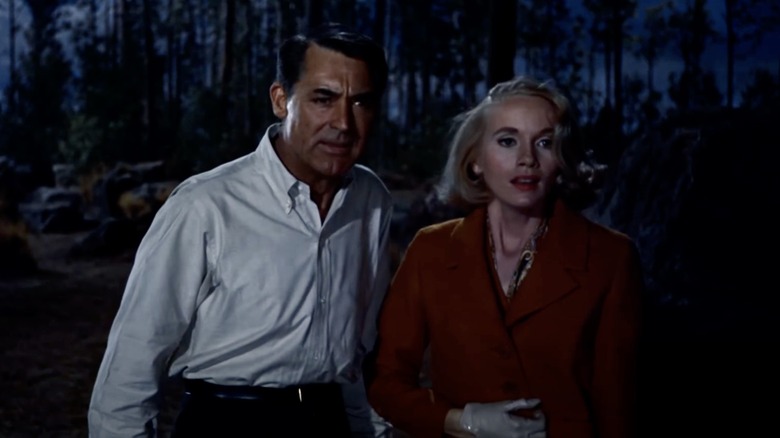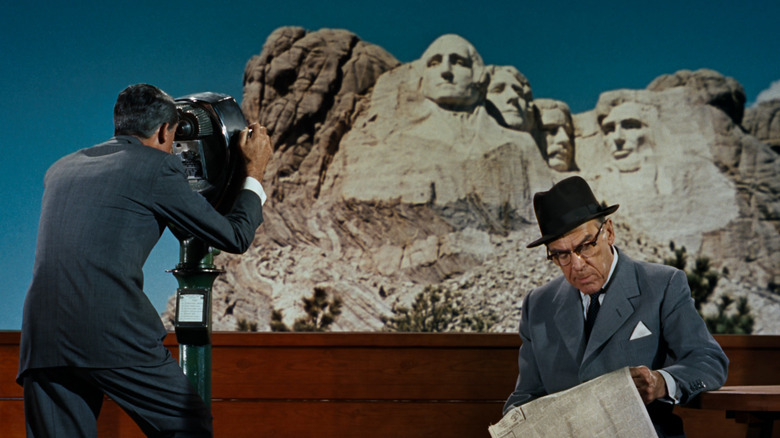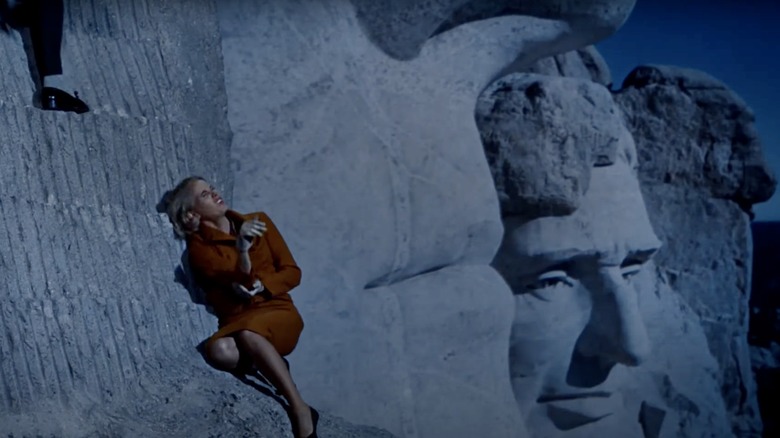The North By Northwest Scene That Sparked A Government Controversy
The climactic set piece in Alfred Hitchcock's classic spy thriller "North by Northwest" sees Cary Grant and Eva Marie Saint being chased down the side of Mount Rushmore, the national memorial with the faces of four U.S. presidents carved into a mountainside in South Dakota. Hitchcock originally wanted to film the chase scene on the real Mount Rushmore, with "a man hanging onto [Abraham] Lincoln's eyebrows." As it is, he used mockups (full-size models) of the monument to film the scene, but he also interspersed real footage of it throughout the movie.
That almost never happened, however, as the National Park Service and the U.S. Department of the Interior was concerned about Hitchcock and his cast and crew potentially "desecrating" the monument. As PBS details, the director had obtained a permit to film at Mount Rushmore with the stipulation that he could not shoot any violence near the presidential sculptures of Lincoln, Theodore Roosevelt, Thomas Jefferson, and George Washington. Yet, when Hitchcock showed a reporter a napkin sketch of how he planned to stage the scene, it made the local newspaper in Rapid City, which neighbors the Black Hills where the monument is located.
As "North by Northwest" became the focus of such publicity, the Park Service promptly rescinded Hitchcock's permit, forbidding him from filming at the real Mount Rushmore or even using his planned mockups of the president's faces in any scenes with live actors. The agency later consented to the mockups but imposed some controlling measures about how the president's faces were to be filmed. Again, no violence was to be shown, but it seems Hitchcock always planned to depict some and was just playing nice so that he could gain access to the cafeteria, parking lot, and viewing terraces surrounding the actual monument.
Hitchcock's Creative Differences with the Government
Alfred Hitchcock filmed the close-ups of his actors climbing down the mountain at the MGM Studios lot in Culver City, California. Yet, they are so skillfully interwoven with the other South Dakota location footage in "North by Northwest" that the government was concerned the moviegoing public would get the wrong idea and think it had consented to Hitchcock and his actors traipsing all over Mount Rushmore and using it as the scene of character deaths.
As early reviews of "North by Northwest" came pouring in, it became apparent that the movie did not comply with the government's original wishes or demands, and that Hitchcock had never intended to do so. He was telling the officials what they wanted to hear so he could make his movie and give audiences another spectacle featuring recognizable U.S. landmarks (something he had done the year before in "Vertigo.")
Now that "North by Northwest" was in the can, there was not much officials could do except impose tougher restrictions on future Hollywood productions involving national parks. At the same time — like a filmmaker taking a generic "Alan Smithee" credit for a project they've disowned after a loss of creative control — the government asked MGM to remove the part in the credits of "North by Northwest" reading, "We gratefully acknowledge the cooperation of the United State[s] Department of the Interior and the National Park Service in the actual filming of the scenes at Mount Rushmore National Memorial, South Dakota."
Which Is the Real Desecration?
The irony of all this is that the U.S. government was concerned about Alfred Hitchcock desecrating a "Shrine of Democracy," but Mount Rushmore itself is the subject of some controversy because it's built on land that was promised to the indigenous Lakota or Teton Sioux tribe in an official U.S. treaty in the 1800s. The Lakota regard the Black Hills as sacred ground, but after the treaty, it became the site of a gold rush — as seen on the HBO series "Deadwood."
Plans for a monument with Native American figures were scrapped for one with the faces of four white men, and it was only a century later that the U.S. Supreme Court would make a multimillion-dollar restitution to the Sioux Nation for what some still consider stolen land. This is part of the reason why it sparked protests (via the BBC) when then-President Donald Trump held a campaign rally at Mount Rushmore on Independence Day in 2020.
The biopic "Hitchcock," starring Anthony Hopkins and Helen Mirren, features one dramatized scene with Hitchcock sitting in the bathtub, reading a New York Times review of "North by Northwest" in which the critic says he "found the climax to be overdrawn." In real life, Hitchcock may have stolen a few shots of Mount Rushmore for his movie, but some might say that pales in comparison to a Trump rally being held on sacred ground — with a monument to the Euro-centric patriarchy of the nation's founding fathers in the background.


